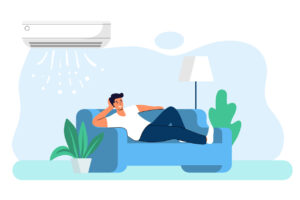Is your heating and cooling system acting up or not working at all? While it might feel like rocket science, troubleshooting your air conditioner and furnace actually starts with a pretty simple process. Many heating and cooling problems do ultimately require a licensed technician to repair, but chances are that you can figure out what exactly isn’t working or at least narrow down the possibilities before you contact a repair company. Any information you can provide before the technician arrives may speed up the process and reduce the repair’s cost.
First Steps for Homeowners
Homeowners may think their system has permanently shut down when their HVAC system shuts off and won’t turn on, but the very first place you should check is your circuit breaker panel. If your thermostat doesn’t light up, then there is a very good chance that the breaker has flipped and simply needs to be reset.
However, most heating and cooling problems are a bit more subtle. The air conditioner might blow lukewarm air during the summer, and the system clearly has power, but the condenser isn’t working properly. In this case, check both refrigerant lines that lead from the condenser. If one of the lines is frozen, there might be a leak that has reduced the system’s coolant pressure. On the other hand, poor heating performance typically stems from a broken heating element.
Is the air coming out of your vents humid and stale? Your air handler — the big unit that typically sits inside your home — has a removable cover that you can easily pop off by loosening a handful of screws. We recommend checking the manual that came with the system to identify the correct screws if you’ve never done it before. However, it’s the easiest way to check for standing water in the bottom of the unit, which usually indicates a clogged condensate line or broken condensate pump.
If there’s no standing water, then you might want to check your thermostat’s fan settings. Most units have two fan settings: auto and on. The auto fan setting will run whenever the system tries to heat or cool your home, but the on fan setting will run the air handler’s fan continuously even when the AC is turned off. This can bring in humid air from outside and actually make your system work harder to cool the warm, humid air coming into your home.
When your system is working longer and harder to maintain a comfortable temperature, the problem might be something as simple as a dirty air filter. Air filter media are designed to be replaced once about every six months, and if you generate a lot of dust either with a home renovation or pets, you’ll get better performance by replacing the air filter even more often. When the filter gets dirty and clogged, it blocks the flow of air, and the system has to run longer to maintain the same temperature.
Maintenance and Emergency Repairs
Some issues, such as a slight loss in heating performance, are best left to regular service calls. Preventive service is the most cost-effective way to keep your system running at peak performance levels while extending its lifespan and reducing your utility bills. Maintenance plans often include savings on repairs and other services, which can easily knock $100 or more off of your repair bill.
However, many issues need to be taken care of immediately. Schedule a repair as soon as possible if you notice any of the following:
- No airflow
- Poor heating and cooling performance
- Humid, stale air
- Rattling or other strange noises from your air handler or condenser
- Water pooling up on the floor near the air handler
Because HVAC problems have a way of multiplying if left unfixed, the sooner you repair any issues you encounter, the cheaper your repair bill is likely to be. Need to schedule a repair or sign up for a service plan? Give Doc Savage Heating And Air Conditioning, Inc. a call.



